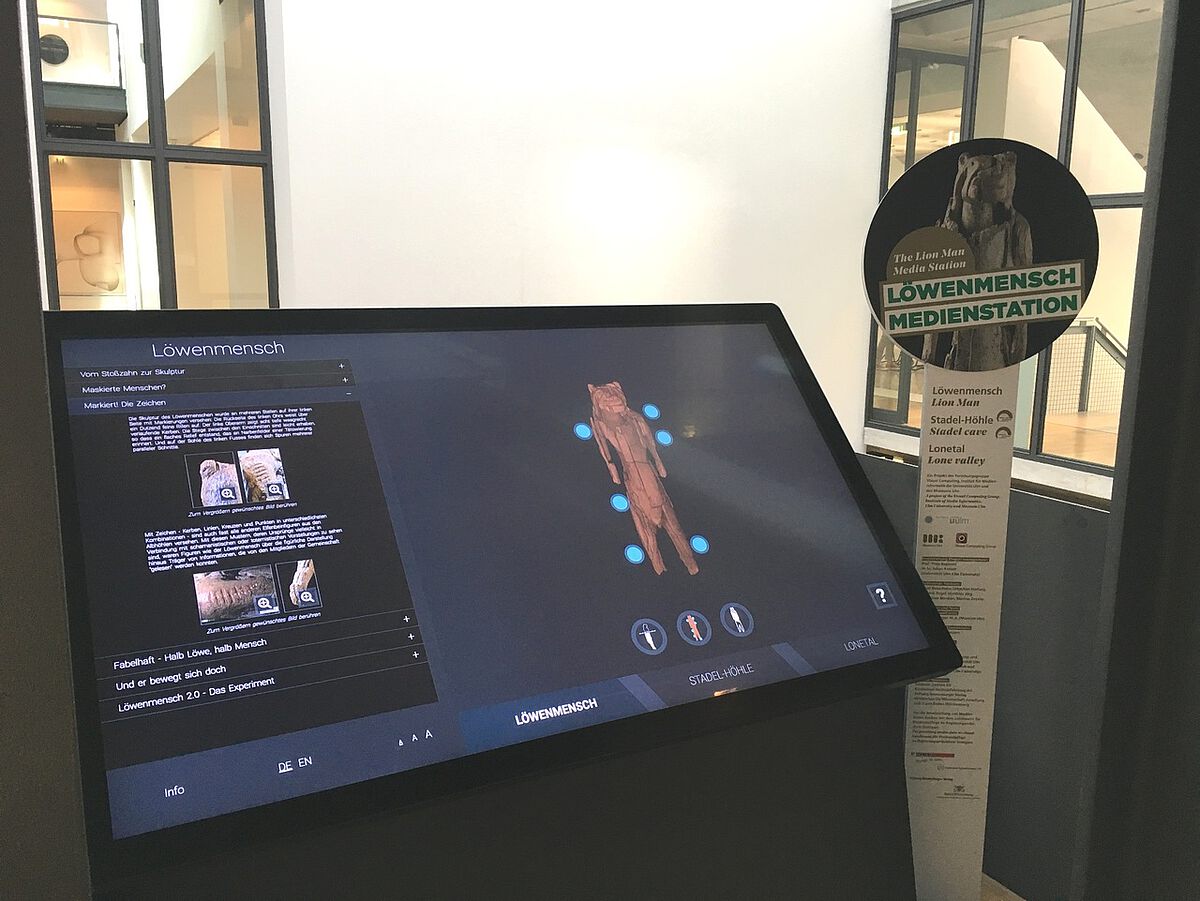Lion man Project
Creating a media station for the Ulm Museum
Lion man media station in action. The touch table mastered its
premiere
at the Ulm Museum — German video by
regio.tv
What is this Lion man and why does he have a project?
The largest and most spectacular ivory figure is the Lion Man, a mythical creature depicting animal and human. Fragments of the sculpture had been discovered in the Stadel Cave at the Hohlenstein in the Lone Valley, on the last day of the excavation campaign in 1939. The excavations were abandoned because of the beginning of the Second World War. It was not until more than 30 years later that the ivory pieces had been recognized as parts of a sculpture, and it took another two decades before the statuette was professionally restored. — loewenmensch.de
The [lion man] media station was developed in a joint study project with the Institute for Media Informatics at Ulm University. Not only photos, films and texts can be viewed via a touch table, the lion man interactively reveals his "inner life" in all details in three-dimensional views. In addition, you can take a virtual tour through the Stadel cave or you can go on a journey of discovery through the landscape of the Lone Valley 40,000 years ago, which was shaped by the Ice Age. The station offers all information in German and English language — loewenmensch.de/aktuelles
Challenges and Motivation
 Photo uni-ulm.deThe lion man media station is based on the inviwo.org framework
also developed at Ulm University in cooperation with Linköping
University. This framework was originally intended to visualize
scientific data like point clouds or medical imaging
information. One big challenge was to melt this framework into a
robust and informative touch UI. The screen is split into a
three dimensional area on the right and an info panel on the
left. Points of interest in the 3D view funcion as buttons that
show extra information on the info panel. The history of the
lion man is presented by short videos, descriptions and images.
To adapt to different user types with different capabilities,
the font-size and language can be adapted. Touch buttons were
over sized to easily hit them.
Photo uni-ulm.deThe lion man media station is based on the inviwo.org framework
also developed at Ulm University in cooperation with Linköping
University. This framework was originally intended to visualize
scientific data like point clouds or medical imaging
information. One big challenge was to melt this framework into a
robust and informative touch UI. The screen is split into a
three dimensional area on the right and an info panel on the
left. Points of interest in the 3D view funcion as buttons that
show extra information on the info panel. The history of the
lion man is presented by short videos, descriptions and images.
To adapt to different user types with different capabilities,
the font-size and language can be adapted. Touch buttons were
over sized to easily hit them.
Some Challenges:
- Thick touch layer created translation in visual image. Test users sometimes touched lower than button touch area. This phenomenon can also be seen at ATMs or ticket machines.
- What if a user leaves the table in a messy state. Weird 3D view angles or videos paused on a black screen. New visitors will get confused and can't explore the media station as intended.
- The system has to start up and work from scratch without the help of any professional. There shouldn't be any extra training necessary to set up the media station every opening morning.
- This machine will not widthstand any serious penetration test, but it is secure enough for the user not to stumble outside the intended application.
Impressions from the exhibition at the Ulm Museum

Different viewing modes let the user see inside the lion man. Users can put a crossection at any location into the lion man. Predefined crossections let the user see the most interesting parts in no time. Image from loewenmensch.de, where you can also find the whole background story to the finding and further excavation of the lion man.

German State Secretary Petra Olschowski (right) and German Parliamentarian Martin Rivoir test the media station — augsburger-allgemeine.de
